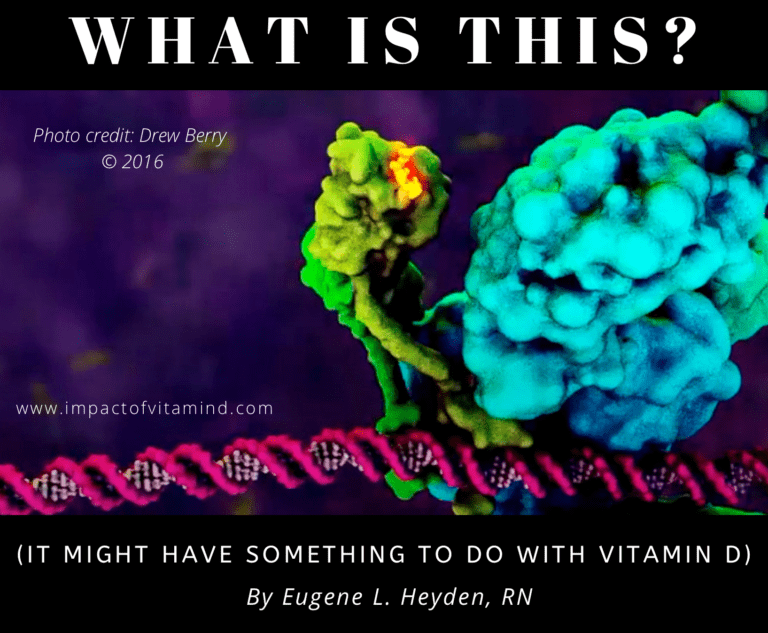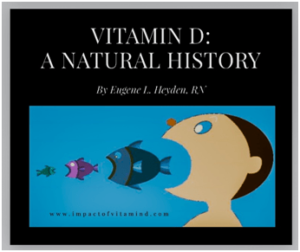WHAT IS THIS?

Last update: 12-15-23
By Eugene L. Heyden, RN
Vitamin D has work to do. Its primary job is to interact with our DNA to allow genetic events to occur. Somehow, a molecule of vitamin D finds its way within the nucleus of a cell, a molecular binding occurs between vitamin D and a specific, pre-positioned protein called the vitamin D receptor (VDR), and the magic happens. How it all works is truly amazing. It will take a great little video to give us a glimpse of just how amazing the whole thing is. And do I have a video for you!
In the image above, taken from the accompanying video, what you see is a large molecular machine (looks like an alien brain with a blue frontal lobe). The green thing, seemingly attached to and projecting from the alien brain-like thing is the VDR. Also visible is a yellowness near the top of the DVR—that’s a molecule of vitamin D. The ropey structure at the bottom of the image is a segment of DNA destined to respond and fulfill a purpose. Not much goes on with this DNA segment until the conditions are just right. Once a molecule of vitamin D binds the VDR, a chain reaction is triggered. The alien brain-like thing changes shape and releases a protein that unzips the segment of DNA in order to expose a portion of it to allow the creation of a string of instructions. The instructions are subsequently used by the cell to create things that are useful, such as proteins that maintain health and defend against disease. To see how this all transpires, and at an unbelievable rate of speed, watch this incredible video:
Impressed, aren’t you? (I’m blown away!) But there is a problem, a big problem.
Most of us are vitamin D deficient. Therefore, most of us will not be using our alien brain-like things at full capacity. Protection against disease is compromised. Many fall victim. Lives are lost. Don’t believe me? Listen up!
“A more recent analysis estimated that currently between 50.000–63,000 Americans and 19,000–25,000 individuals living in the United Kingdom annually die prematurely from cancer due to vitamin D deficiency.” (Spina et al., 2006, emphasis added)
“Chronic vitamin D deficiency may have serious adverse consequences, including increased risk of hypertension, multiple sclerosis, cancers of the colon, prostate, breast, and ovary, and type 1 diabetes.” (Holick, 2003)
So, it would seem that becoming vitamin D sufficient is not just something else to do. It is a matter of life and death. Does your physician think it is a matter of life and death? I’ll let you be the judge.
“. . . health professionals need to ‘broaden their horizon’ and think of vitamin D in more global health terms that incorporate vitamin D’s true role as a hormone. The vitamin D endocrine system is the only steroid endocrine system in the body that is almost always limited by substrate [stuff to work with] availability because of latitude, lifestyle, race/skin pigmentation, sunlight exposure, and other factors.” (Wagner et al., 2008, emphasis added)
“Vitamin D deficiency and its consequences are extremely subtle but have enormous implications for human health and disease. It is for this reason that vitamin D deficiency continues to go unrecognized by a majority of health professionals.” (Holick, 2003, emphasis added)
Related post (Click on image to open)
References
Holick MF 2003 Vitamin D: A Millenium Perspective. Journal of Cellular Biochemistry 88:296–307
Spina CS, Tangpricha V, Uskokovic M, Adorinic L, Maehr H, Holick MF 2006 Vitamin D and Cancer. Anticancer Research 26:2515–2524
Wagner CL, Taylor SN, Hollis BW 2008 Does Vitamin D Make the World Go “Round”? Breastfeeding Medicine 3(4):239–250
Disclaimer: This article is presented solely for informational purposes. The information contained herein should be evaluated for accuracy and validity in the context of opposing data, new information, and the views and recommendations of a qualified health care professional, and not to be substituted for professional judgment and guidance or to provide reason to neglect or delay appropriate medical care. It is the reader and reader only who bears the responsibility for any actions that could be construed as being a response to the information contained herein. The statements and opinions expressed by the author have not been reviewed or approved by the FDA or by any other authoritative body, nor is the author endorsing any product or specific therapy. This article is offered to the reader to broaden his or her understanding of the issues discussed and to help identify options that may be suitable for the individual to pursue, on behalf of self or others, under approval and direction of a qualified physician. The author and publisher offer no guarantees of the accuracy or validity of the quotations incorporated into this article or the accuracy or validity of the information presented by the resources that are herein recommended.
Copyright © 2016–2022 Eugene L. Heyden, RN
All Rights Reserved

